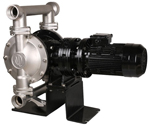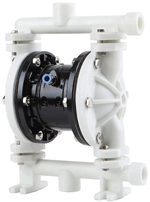Diaphragm Pump Basics
The Diaphragm pump, also known as control pump, is the main type of actuator. It changes the fluid flow with the help of power operation by receiving the control signal output by the adjustment control unit. The function of the diaphragm pump in the control process is to accept the control signal of the regulator or computer, change the flow rate of the adjusted medium, and maintain the adjusted parameters within the required range, so as to achieve the automation of the production process. To realize the adjustment and control of a certain parameter of the process, such as temperature, pressure, flow, liquid level, etc., the diaphragm pump is inseparable.
Main Material
There are five commonly used materials for air diaphragm pumps: plastic, aluminum alloy, cast iron, stainless steel, and Teflon. Electric diaphragm pumps are available in four of these materials: plastic, aluminum alloy, cast iron, and stainless steel. Diaphragm pump diaphragms are installed in various special occasions according to different liquid media, such as nitrile rubber, neoprene rubber, fluorine rubber, polytetrafluoroethylene, polytetrahexaethylene, etc., to pump various media to meet the needs.
Types of Diaphragm Pumps
Air operated single diaphragm pump
The pneumatic diaphragm pump uses compressed air as the power source. It is a positive displacement pump whose volume changes due to the reciprocating deformation of the diaphragm. Its working principle is similar to that of a plunger pump.
Electric diaphragm pump
 The motor on the electric diaphragm pump drives the diaphragms on the left and right end plungers to reciprocate one after the other through the gear box. In the left and right pump chambers, the movement of the upper and lower four one-way ball valve diaphragms causes the change of the volume in the working chamber, forcing the four one-way ball valves to open and close alternately, so as to continuously suck and discharge the liquid.
The motor on the electric diaphragm pump drives the diaphragms on the left and right end plungers to reciprocate one after the other through the gear box. In the left and right pump chambers, the movement of the upper and lower four one-way ball valve diaphragms causes the change of the volume in the working chamber, forcing the four one-way ball valves to open and close alternately, so as to continuously suck and discharge the liquid.
Air operated double diaphragm pump
 Air operated double diaphragm pumps are powered by compressed air, nitrogen or natural gas. The main directional (pneumatic) control valve distributes compressed air to the gas chamber, applying uniform pressure to the inner surface of the diaphragm. At the same time, the discharged gas is discharged from the rear of the other side of the pump through the guide port of the gas valve assembly. The air diaphragm pump mechanically pulls the suction diaphragm through the stroke. The inner plate of the pneumatic double-diaphragm pump contacts the aligned drive plunger, and moves the guide valve core. After the pilot valve is activated, a pressure signal is sent to the other end of the main directional air valve, and the AODD pump changes the direction of the compressed air to the other side of the internal chamber.
Air operated double diaphragm pumps are powered by compressed air, nitrogen or natural gas. The main directional (pneumatic) control valve distributes compressed air to the gas chamber, applying uniform pressure to the inner surface of the diaphragm. At the same time, the discharged gas is discharged from the rear of the other side of the pump through the guide port of the gas valve assembly. The air diaphragm pump mechanically pulls the suction diaphragm through the stroke. The inner plate of the pneumatic double-diaphragm pump contacts the aligned drive plunger, and moves the guide valve core. After the pilot valve is activated, a pressure signal is sent to the other end of the main directional air valve, and the AODD pump changes the direction of the compressed air to the other side of the internal chamber.
Diaphragm Pump Features
Pneumatic single diaphragm pump
- The pump will not be overheated, no harmful gas will be discharged, no electric spark will be generated, and it will not be easily blocked.
- The agitation of the material is minimal, and it is suitable for the transportation of unstable substances.
- The flow can be adjusted, and a throttle valve can be installed at the material outlet to adjust the flow.
- It has the function of self-priming.
- It can be run dry without danger.
- The fluids that can be transported are extremely wide, from low-viscosity to high-viscosity, from corrosive to viscous.
- There is no complicated control system, no cables, fuses, etc.
- Small size, light weight, easy to move.
- No lubrication is required, so maintenance is easy, and the working environment will not be polluted by dripping.
- The pump can always maintain high efficiency and will not be reduced due to wear.
Electric diaphragm pump
- No need to irrigate and divert water, and the self-priming capacity is more than 7 meters.
- The passing performance is good, and the particles and mud with a diameter of less than 10 mm can pass through effortlessly.
- Since the diaphragm will separate the conveyed medium from the transmission mechanical parts, the medium will never leak out. And the pump itself has no shaft seal, and the service life is greatly extended.
- Small size and light weight. Due to the planetary cycloid transmission structure, the pump type has a small size, as compared with the same type of pump, its volume and weight are reduced by about half.
Air operated double diaphragm pump
The characteristics of the pneumatic double diaphragm pump are similar to those of the single-diaphragm pump, except that the double diaphragm pump refers to double suction chambers, and the single-diaphragm pump has only one suction chamber. However, the diaphragm pump pressure cannot be increased and is limited by the air source pressure. The flow rate of diaphragm pumps is usually not too large, and most of them are used in small systems. It is different from the traditional centrifugal pump used in large flow.
How to Choose a Diaphragm Pump?
The selection of the valve body type of the diaphragm pump is the most important link in the option of the diaphragm pump. There are many types of diaphragm pump valve bodies, including straight-through single-seat, straight-through double-seat, angle, diaphragm, small flow, tee, eccentric rotation, butterfly, sleeve, spherical, etc. Before selecting a valve, it is necessary to carefully analyze the medium, process conditions and parameters of the control process, collect enough data, understand the requirements of the system for the diaphragm pump, and determine the type of valve to be used according to the collected data. In the specific selection, the following aspects can be considered:
- The shape and structure of the valve core are mainly considered according to the selected flow characteristics and unbalanced force.
- Wear resistance. When the fluid medium is a suspension containing a high concentration of abrasive particles, the valve core and valve seat interface will be severely rubbed every time they are closed. Therefore, the flow path of the valve should be smooth, and the inner material of the valve should be hard.
- Corrosion resistance. Due to the corrosive nature of the medium, a valve with a simple structure should be selected as far as it can meet the adjustment function.
- The temperature and pressure of the medium. When the temperature and pressure of the medium are high and the change is large, the material of the valve core and the valve seat should be selected for the valve with small changes in temperature and pressure.
- Prevent flash evaporation and cavitation. Flash evaporation and cavitation only occur in liquid media. In the actual production process, flash evaporation and cavitation not only affect the calculation of the flow coefficient, but also form vibration and noise, which shorten the service life of the valve. Therefore, the valve should be prevented from flashing and cavitation when selecting the valve.
Diaphragm Pump Applications
Since the diaphragm pump has some incomparable characteristics of the traditional pump, the diaphragm pump in the world has gradually invaded the market of other pumps since its birth, and occupies a part of the market. Diaphragm pumps have an absolute dominant position in the paint and ceramic industries. In some other industries, such as environmental protection, wastewater treatment, construction, sewage, and fine chemicals, it is expanding its market share and has an irreplaceable position with other pumps. The diaphragm pump can absorb all kinds of corrosive liquids, liquids with particles, high viscosity, volatile, flammable and highly toxic liquids. Pneumatic pumps are reliable and low-cost in flammable and explosive environments, such as the delivery of fuel, gunpowder, and explosives. It can still work stably in harsh construction sites, such as construction sites, industrial and mining wastewater discharge environments.

